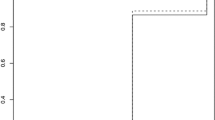Abstract
In this paper, we first define risk in an axiomatic way and a class of utility functions suitable for the so-called mean-risk analysis. Then, we show that, in a portfolio selection problem with multiple risky investments, an investor who is more risk averse in the Arrow-Pratt sense prefers less risk, in the sense of this paper, with less mean return, and an investor who displays increasing (decreasing) relative risk aversion becomes more conservative (aggressive) as the initial capital increases. The risk aversion effect for diversification on optimal portfolios is also discussed.
Similar content being viewed by others
References
K.J. Arrow,Essays in the Theory of Risk-Bearing (Markham, Chicago, 1971).
D.P. Bertsekas, Necessary and sufficient conditions for existence of an optimal portfolio, J. Econ. Theory 8 (1974) 235–247.
E.J. Elton and M.J. Gruber,Modern Portfolio Theory and Investment Analysis, 3rd ed. (Wiley, New York, 1987).
P.C. Fishburn and R.B. Porter, Optimal portfolios with one safe and one risky asset: Effects of changes in rate of return and risk, Manag. Sci. 22 (1976) 1064–1073.
B.V. Gnedenko and A.N. Kolmogorov,Limit Distributions for Sums of Independent Random Variables (translated from the Russian and annotated by K.L. Chung, with an appendix by J.L. Doob) (Addison-Wesley, Cambridge, MA, 1954).
G. Hanoch and H. Levy, The efficiency analysis of choices involving risk, Rev. Econ. Studies 36 (1969) 335–346.
J.E. Ingersoll Jr.,Theory of Financial Decision Making (Rowman and Littlefield, New York, 1987).
I. Jewitt, Risk aversion and the choice between risky prospects: The preservation of comparative statics results, Rev. Econ. Studies 54 (1987) 73–85.
I. Jewitt, Choosing between risky prospects: The characterization of comparative statics results, and location independent risk, Manag. Sci. 35 (1989) 60–70.
K.G. Kallberg and W.T. Ziemba, Comparison of alternative utility functions in portfolio selection problems, Manag. Sci. 29 (1983) 1257–1276.
S. Karlin,Total Positivity, Vol. 1 (Stanford University Press, Stanford, 1968).
M. Kijima and M. Ohnishi, Stochastic dominance by functional characterization approach: Fundamental results and applications, Technical Report No. 92-12, Graduate School of Systems Management, The University of Tsukuba, Tokyo (1992).
D. Kira and W.T. Ziemba, The demand for a risky set, Manag. Sci. 26 (1980) 1158–1165.
H. Konno, Piecewise linear risk functions and portfolio optimization, J. Oper. Res. Soc. Japan 33 (1990) 139–156.
H. Konno and H. Yamazaki, A mean-absolute deviation portfolio optimization model and its application to Tokyo stock market, Manag. Sci. 37 (1991) 519–531.
E. Lehmann, Ordered families of distributions, Ann. Math. Statist. 26 (1955) 399–419.
H. Levy, Stochastic dominance and expected utility: Survey and analysis, Manag. Sci. 38 (1992) 555–593.
Y. Li and W.T. Ziemba, Characterizations of optimal portfolios by univariate and multivariate risk aversion, Manag. Sci. 35 (1989) 259–269.
P.L. McEntire, Portfolio theory for independent assets, Manag. Sci. 30 (1984) 952–963.
J. von Neumann and O. Morgenstern,Theory of Games and Economic Behavior, 3rd ed. (Princeton University Press, Princeton, NJ, 1953).
J.W. Pratt, Risk aversion in the small and the large, Econometrica 32 (1964) 122–136.
S.J. Press,Applied Multivariate Analysis (Holt, Rinehart and Winston, New York, 1972).
R.T. Rockafellar,Convex Analysis (Princeton University Press, Princeton, NJ, 1970).
S.M. Ross,Stochastic Processes (Wiley, New York, 1983).
M.E. Rubinstein, A comparative statics analysis of risk premiums, J. Bus. 12 (1973) 605–615.
D. Stoyan,Comparison Methods for Queues and Other Stochastic Models (edited with revision by D.J. Daley) (Wiley, Chichester, 1983).
W.T. Ziemba, Choosing investments when the returns have stable distributions, in:Mathematical Programming in Theory and Practice, eds. P.L. Hammer and G. Zoutendijk (North-Holland, Amsterdam, 1974) pp. 443–482.
Author information
Authors and Affiliations
Rights and permissions
About this article
Cite this article
Kijima, M., Ohnishi, M. Mean-risk analysis of risk aversion and wealth effects on optimal portfolios with multiple investment opportunities. Ann Oper Res 45, 147–163 (1993). https://doi.org/10.1007/BF02282046
Issue Date:
DOI: https://doi.org/10.1007/BF02282046




